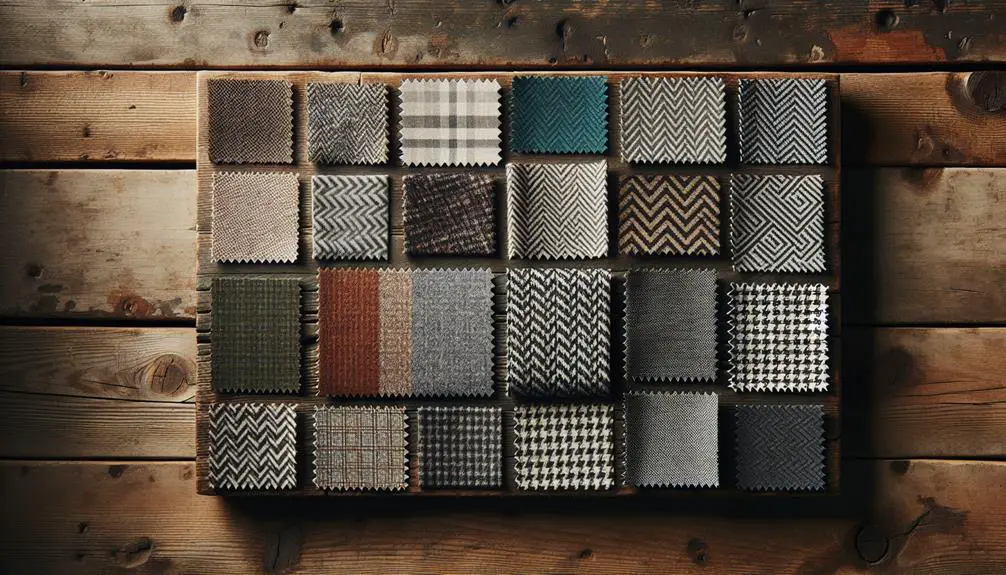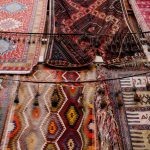I've always been a fan of tweed for its classic look and durability, but recently I've been exploring wool flannel as a similar alternative. Like tweed, wool flannel offers warmth and a rich texture that works well for everything from blazers to winter skirts. It's fascinating to observe how both fabrics provide that snug comfort ideal for cooler climates, yet they maintain a certain stylistic flexibility. I'm curious, though, about how other fabrics might stack up against tweed regarding texture, weight, and overall usability. What do you all think—any experiences with materials that rival the classic charm of tweed?
Table of Contents
Key Takeaways
- Wool Flannel: Offers a similar softness and warmth, making it a good alternative for different seasonal needs.
- Herringbone: Features a unique zigzag texture and durable weave, akin to tweed's robustness.
- Houndstooth: Known for its distinctive check pattern and historical richness, comparable to tweed's traditional appeal.
- Bouclé: Provides a unique textured feel with its looped yarns, echoing tweed's tactile quality.
- Barleycorn Weaves: Exhibits a pebbled surface and complex design, offering depth and sophistication similar to tweed.
Understanding Tweed's Unique Qualities
Tweed's charm lies in its durable yet stylish texture, making it a staple for both fashion and function. When I explore its fabric composition, I'm always impressed by how it balances sophistication with practicality. Traditionally, tweed is crafted from wool, which inherently grants it fantastic insulation properties. However, it's the unique weaving process that adds a dense, tight structure to the fabric, enhancing its weather resistance.
This resilience to various weather conditions makes tweed an ideal choice for outerwear. I've worn it on damp autumn days and chilly winter walks, and it consistently keeps me warm and dry without the bulk that other fabrics might add. The secret really lies in the fibers themselves, which are naturally water-resistant to some degree, thanks to the lanolin in wool. This characteristic is a godsend, especially when I'm caught in unexpected drizzles.
Moreover, the robust nature of tweed means it holds up well over time. It doesn't just resist the weather; it resists wear and tear, too. For anyone looking to master the art of functional yet fashionable dressing, understanding and utilizing tweed's unique properties is key.
Wool Flannel: A Cozy Alternative
If you're seeking a softer, yet equally warm alternative to tweed, wool flannel might just be the perfect fit. Known for its gentle feel, flannel softness is a major draw for those of us who find tweed a bit too scratchy for comfort. Plus, it's just as capable of keeping you warm during those chilly months.
Here's how you can get the most out of your wool flannel garments:
- Choose the Right Weight: Flannel comes in various weights. Lighter flannel is great for fall, while heavier flannel suits the dead of winter.
- Care for It Properly: Flannel maintenance isn't as challenging as it sounds. Simply wash in cold water and air dry to avoid shrinkage and maintain the fabric's softness.
- Layer Smartly: Wool flannel layers beautifully. Pair it with a light t-shirt or a sturdy wool sweater, depending on the weather.
- Consider the Weave: The tighter the weave, the warmer the fabric. If warmth is your goal, opt for a densely woven flannel.
Herringbone's Distinctive Texture
Herringbone's distinctive zigzag pattern not only catches the eye but also adds a unique texture that sets it apart from smoother fabrics like tweed. If you're keen to understand how this texture is achieved, it's all about the weaving techniques involved. Unlike the more uniform weave of tweed, herringbone is created through a specific arrangement where the threads are aligned in opposite V-shapes, mimicking the skeleton of a herring fish—hence the name.
Delving deeper into its pattern origins, herringbone dates back to the Roman Empire, used primarily in road paving which speaks volumes about its durability and intricate design. This historical context isn't just cool trivia; it influences how we perceive and utilize the fabric today, ensuring that items made from herringbone aren't only stylish but also incredibly sturdy.
In my experience, mastering the use of herringbone in design projects requires a good grasp of its textural impact and how it plays with light and shadow. This understanding allows for innovative uses beyond the traditional blazers or coats, exploring how its depth can enhance accessories or home décor, creating pieces that stand out with a sophisticated, historical nod.
Houndstooth and Its Classic Appeal
Now, let's talk about houndstooth and why it's still so popular.
It's got a rich history, popping up in fashion at various points, and it's not just for old-school looks anymore.
Whether you're dressing up or going casual, houndstooth patterns can really make your outfit stand out.
Origins of Houndstooth
Houndstooth, with its distinctive broken check pattern, originated in the Scottish Lowlands. This pattern's history is fascinating, evolving from a simple two-color mix to an array of color combinations that highlight its versatility. Here's a quick rundown to deepen your appreciation:
- Roots in Wool: Initially woven from sheep's wool, houndstooth was a practical choice for shepherds.
- Symbol of Status: Over time, it became a symbol of sophistication in British fashion.
- Color Evolution: Originally black and white, the pattern now incorporates multiple colors, enhancing its adaptability.
- Global Spread: From Scotland, the appeal of houndstooth spread worldwide, influencing fashion on a global scale.
Understanding these elements really shows why houndstooth remains a beloved classic!
Houndstooth in Modern Fashion
Why has houndstooth remained a staple in modern fashion, you might wonder? Its timeless appeal lies in its unique pattern evolution and adaptability to shifting color trends.
Originally a duo-tone, the pattern has embraced multicolor variations, integrating seamlessly into different fashion eras. Designers have played with scale and colors, pushing the boundaries from traditional black and white to incorporating bold, contemporary hues.
This adaptability makes houndstooth incredibly versatile, fitting into various style aesthetics from edgy streetwear to high-end couture. The pattern's ability to evolve while maintaining its classic roots appeals to a broad audience, ensuring its place in the ever-changing fashion landscape.
It's not just about nostalgia; it's about reinvention without losing essence.
Styling With Houndstooth Patterns
Styling with houndstooth patterns offers endless possibilities to elevate any outfit, blending classic charm with modern flair. Here's how you can rock this iconic pattern:
- Play with Color Contrasts: Pair a black and white houndstooth blazer with a bold red scarf or a bright blue handbag. This creates a visual pop that's both sophisticated and eye-catching.
- Mix Patterns Carefully: Combine houndstooth with subtle stripes or polka dots. Make sure the colors harmonize to keep your ensemble from clashing.
- Accessorize Smartly: Opt for houndstooth accessories like scarves, hats, or shoes to add a touch of this pattern without overwhelming your look.
- Layer Thoughtfully: Layer a houndstooth vest over a solid turtleneck or a light chambray shirt. This adds texture and depth to your outfit while maintaining that classic vibe.
Bouclé: Soft and Textured
While tweed offers a traditional appeal, bouclé stands out with its soft, textured feel that adds a unique flair to any outfit. As I've explored fabrics, I've found that understanding bouclé production is key to appreciating its charm. Bouclé is created from looped yarns which give it that distinctive, bumpy texture. These yarns can vary in tightness and loop size, contributing to the fabric's richly textured surface that's perfect for adding dimension to your look.
When it comes to bouclé care, it's simpler than you might think. First off, always check the care label. Most bouclé items should be dry cleaned to maintain their texture and shape. However, for minor spills, a quick spot-clean can do the trick. Avoid wringing or twisting the fabric; it's prone to stretching. If you're a DIY enthusiast, steaming rather than ironing helps preserve the loops and prevents flattening.
Honestly, bouclé's versatility is what sets it apart. It's not just for jackets – think dresses, skirts, and accessories. Each piece brings a touch of sophistication with its voluminous yet delicate appearance, making it a standout choice for those who love to mix texture into their wardrobe.
Donegal: The Irish Cousin
Just as bouclé offers a unique texture, Donegal tweed stands out with its colorful flecks and rugged durability. Originating from County Donegal in Ireland, this fabric has made a significant mark in the fashion world. What sets Donegal tweed apart are the vibrant specks of color, traditionally derived from natural dyes. This characteristic mirrors the rich, varied landscape of its Irish homeland.
What's truly fascinating is the traditional Irish weaving techniques that are still employed today, ensuring each piece is imbued with history and authenticity. The weavers use a loom that's manually operated, making the fabric not just a textile, but a story in itself.
To really appreciate Donegal tweed, here's what you should know:
- Unique Color Flecks: The multicolored specks are randomly blended into the base fabric, reflecting the natural beauty of Donegal's landscape.
- Robust Texture: Known for its durability, Donegal tweed is ideal for outerwear.
- Traditional Irish Weaving: This method preserves the historical integrity and uniqueness of the fabric.
- Versatile Donegal Patterns: These patterns aren't just beautiful; they're symbolic, often telling a tale or representing a family heritage.
Embracing Donegal tweed means appreciating a piece of Irish culture and its age-old craftsmanship.
Harris Tweed: Authenticity and Style
Let's talk about Harris Tweed, a fabric that's as rich in history as it's in style.
We'll explore how it originated, the unique ways it's made, and its standout moments in fashion.
It's not just any tweed; it's a symbol of authenticity and craftsmanship.
Origins of Harris Tweed
Harris Tweed's story begins on the remote Scottish islands of the Outer Hebrides, where the fabric's authenticity and unique style have been meticulously crafted for centuries. It's woven deep into the Hebridean history and reflects a legacy of island craftsmanship that's quite unmatched. Here's why this fabric stands out:
- Deep Roots: The tradition dates back to the 18th century, blending local skills with natural resources.
- Artisan Touch: Each piece is handwoven by islanders in their homes, not in factories.
- Cultural Heritage: The methods used are passed down through generations, preserving both craft and community.
- Local Materials: Only wool from local sheep is used, ensuring the fabric's distinct, rugged quality that's true to its origins.
Unique Production Techniques
Delving into the production techniques of Harris Tweed reveals a blend of age-old methods and precise craftsmanship that truly sets it apart. The weaving processes are meticulous, involving only skilled artisans who maintain the traditional approach. They use specific looms that demand manual operation, ensuring each piece has its unique character and unmatched quality.
The fiber selection is equally vital. Only pure virgin wool is used, sourced directly from local sheep. This choice isn't just about tradition; it's about utilizing a fiber that provides durability, warmth, and a distinct texture. The raw wool is dyed and blended in-house, allowing for a rich palette of colors that remain vibrant even after years of wear.
Iconic Fashion Uses
While the production techniques of Harris Tweed are rooted in tradition, its iconic status in fashion circles is equally remarkable. The fabric's durability and unique patterns have made it a staple for designers who aim to blend rustic charm with sophistication. Here's why it stands out:
- Timeless Appeal: Harris Tweed maintains a classic look that never goes out of style.
- Versatility: It's used in everything from luxury suits to trendy caps.
- Pattern Influence: The intricate weaves and colors inspire modern fashion designs.
- Robustness: Its sturdiness guarantees that garments last, providing long-term value.
These characteristics make Harris Tweed not just a fabric, but a significant player in the fashion world, influencing trends and choices season after season.
Chevron Weaves: A Modern Twist
Chevron weaves often add a contemporary flair to traditional tweed designs. This method involves an inventive approach to pattern innovation, where the classic herringbone pattern is tweaked to create a sharper, more defined 'V' shape that really catches the eye. It's a fantastic example of how weave experimentation can lead to fresh, modern outcomes while still nodding to the old-school charm of tweed.
I've noticed that designers are particularly keen on using chevron weaves when they aim to blend vintage aesthetics with modern sensibilities. The dynamic lines and the illusion of movement within the fabric make it a go-to choice for high-fashion garments that need that extra pop. Plus, the texture of chevron provides a unique tactile experience that stands out in the crowded world of textiles.
But it's not just about looks; the structure of chevron weave also enhances the durability of the fabric. This makes it ideal for everyday wear pieces that require a bit more resilience without sacrificing style. As someone who loves both the timeless appeal and the contemporary edge, I find chevron tweed to be a perfect bridge between the two, allowing for creative freedom and functionality.
Corduroy: The Durable Choice
Now let's talk about corduroy.
I'll cover its unique texture, share some easy care tips, and explore its versatility in various fashion styles.
It's a robust fabric that really holds its own next to tweed.
Corduroy Texture Overview
Corduroy's distinctive ridges, known as wales, make it a robust and stylish fabric choice. I'm delving into why corduroy stands out, especially when you compare it to other fabrics like tweed. Its texture isn't just about looks; it's designed for durability and comfort.
Here's what you need to know:
- Corduroy History: Originally worn by kings, it evolved to workwear due to its resilience.
- Durability: The thick wales form a cushioned barrier, making it tough yet comfy.
- Style Versatility: From casual pants to upscale jackets, it adapts easily.
- Fabric Comparisons: Unlike tweed's rough texture, corduroy offers a softer, ribbed feel which many find more wearable daily.
Understanding these aspects can really enhance your fabric mastery!
Maintenance and Care Tips
To keep your corduroy looking great, you'll need to follow some simple care guidelines. First up, when washing corduroy, avoid using fabric softeners. They can actually weaken the fibers over time. Instead, opt for a gentle detergent. If your corduroy is particularly dirty or if it's a structured piece like a blazer, dry cleaning techniques are your best friend. They help maintain the shape and feel of the fabric.
Here's a quick table to break it down:
| Care Process | Recommendation |
|---|---|
| Washing | Use gentle detergent |
| Using Softeners | Avoid fabric softeners |
| Drying | Tumble dry low or air dry |
| Professional Care | Prefer dry cleaning |
Stick to these tips and your corduroy will stay durable and stylish!
Versatility in Fashion Styles
Why is corduroy considered a versatile choice in fashion?
Well, it's all about its fabric adaptability and style versatility. Here's why I think you'll love mixing corduroy into your wardrobe:
- Texture Variety: It adds a unique texture that can easily spice up an outfit. From fine to chunky ridges, there's a range that fits any style.
- Season Flexibility: Corduroy isn't just for winter; lighter versions are perfect for spring and fall too.
- Color Options: It comes in a spectrum of colors, ensuring you can find the perfect shade to match your mood or the season.
- Durability: Beyond style, it's incredibly durable, making it a practical choice for daily wear.
Barleycorn Weaves: Visual Interest
Barleycorn weaves catch the eye with their intricate, pebbled appearance. They're not just any fabric; they're a rich tapestry of pattern complexity and color blending that elevates any wardrobe piece. I'm particularly drawn to how these weaves play with light and shadow, creating a dynamic look that's both sophisticated and versatile.
Let's break down what makes barleycorn weaves stand out:
| Characteristic | Detail | Impact on Style |
|---|---|---|
| Texture | Pebbled, raised surface | Adds depth, tactile quality |
| Pattern | Complex, interlocking | Visually engaging |
| Color Integration | Subtle, rich color blends | Enhances versatility |
This fabric's charm lies in its ability to blend colors subtly but effectively, making it a perfect contender for those who love a piece that speaks without shouting. Whether it's a jacket or a cozy winter skirt, barleycorn adds a touch of class with its unique texture and intricate patterns. I find it absolutely indispensable for creating outfits that require a bit more personality and visual interest.
Frequently Asked Questions
How Do I Wash and Care for Tweed Garments?
To wash my tweed garments, I typically opt for dry cleaning to preserve their texture. For spot cleaning, I apply gentle stain removal tips, dabbing lightly to avoid damaging the fabric.
What Outfits Pair Well With Tweed Jackets?
I'd pair my tweed jacket with dark jeans for a casual look, or a tailored trouser for more formality. Modern accessorizing and color coordination elevate the outfit, making it stylish and cohesive.
Can Tweed Be Worn in Summer?
I'd say tweed can be worn in summer, but its breathability's key. If it's a lighter weave, you're good to go. Just check the fabric blend for maximum summer suitability!
Is Tweed Appropriate for Formal Events?
I'd say tweed's versatility definitely extends to formal events. Its texture and weight give it a distinguished look, making it quite suitable for those occasions. Always a classy choice in my book!
How Can I Tell if a Fabric Is Real Tweed?
I'd check the texture and look for labels to confirm real tweed. Tweed identification includes examining the weave's density and irregularity. It's about mastering these details to make sure you're getting genuine material.
- Understanding Calico Prints: From Classic Florals to Modern Designs - June 19, 2025
- Calico for Quilting: Why It’s a Popular Choice for Crafters - June 19, 2025
- Your Guide to Buying Cheap Calico Fabric Without Sacrificing Quality - June 19, 2025







